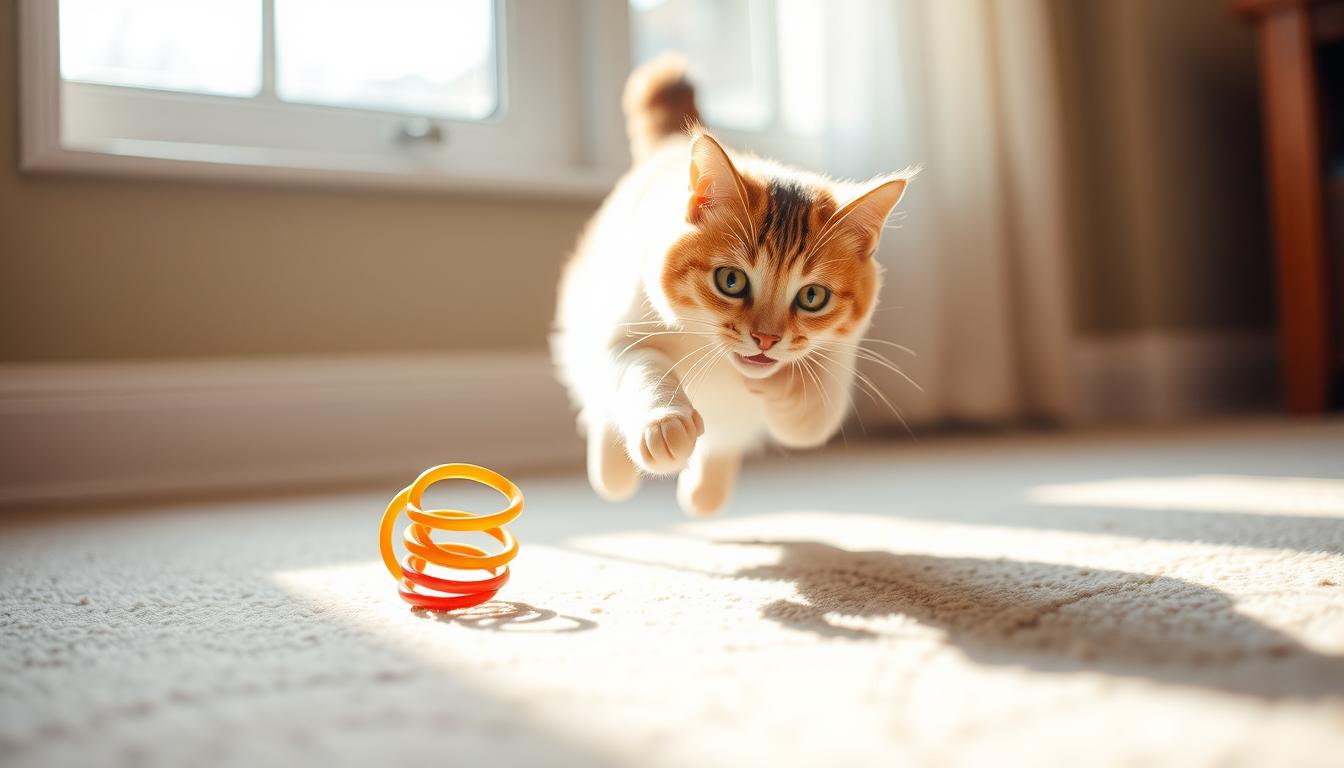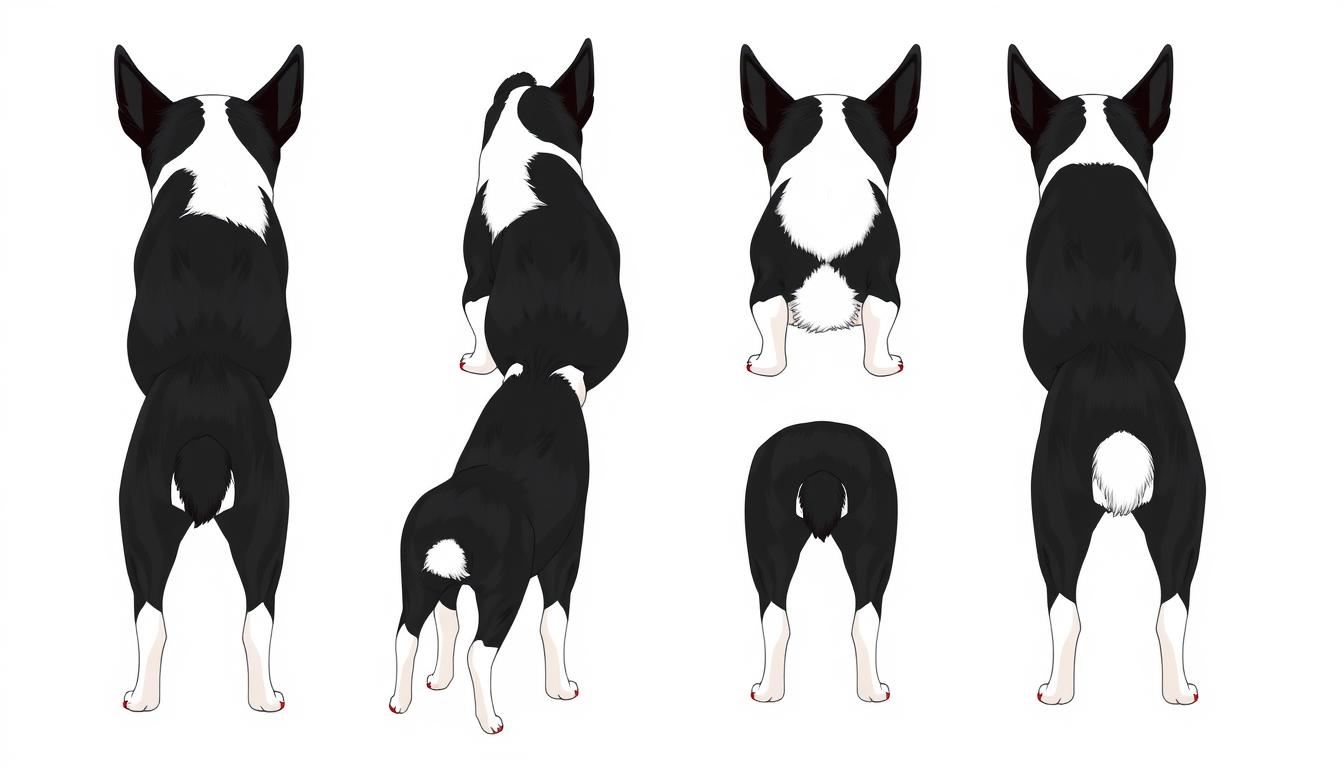Is Your Cat a Threat to Your Sugar Glider? Learn the Risks
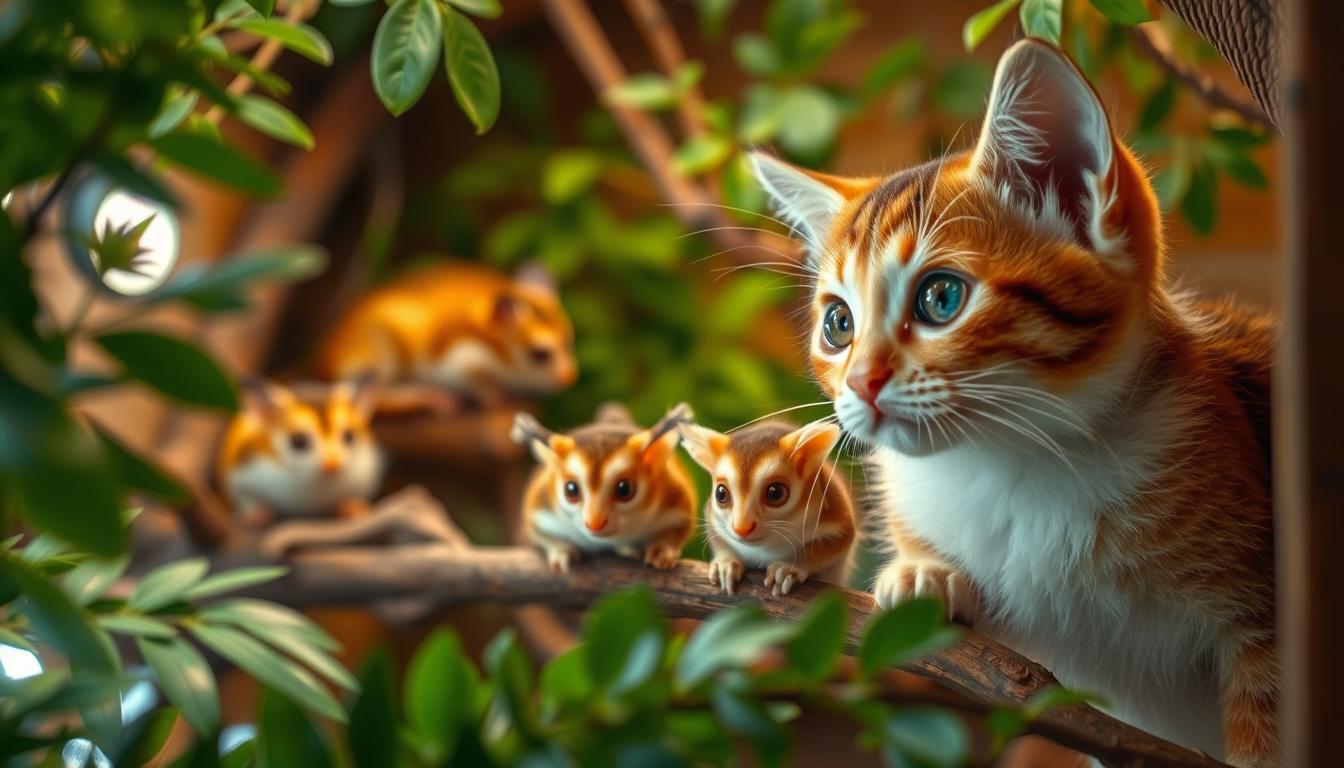
Cats are known as the deadliest predators, killing more animals than any other cause1. If you own a sugar glider, it’s vital to know the dangers of having cats and sugar gliders together. Cats can harm sugar gliders because of the bacteria in their saliva. For more on cat dental care and vet visits, check out cat teeth diagram resources. Sugar gliders can get very sick if they touch a cat’s fluids, which can lead to serious health problems or even death1.
Cats are harmful to sugar gliders because they might see them as food. Pets like cats and dogs carry dangerous bacteria in their mouths. This can be deadly for small animals like hamsters, rats, birds, sugar gliders, and other pets that don’t eat meat1. It’s important to keep pets that eat meat and those that don’t separate to avoid sickness1.
Key Takeaways
- Cats are toxic to sugar gliders due to the bacteria in their saliva.
- Sugar gliders can suffer from various health issues if they come into contact with a cat’s bodily fluids containing Pasteurella bacteria.
- It’s not recommended to house carnivorous and herbivorous pets together due to the risk of cross-contamination with harmful bacteria.
- Cats are natural predators and may view sugar gliders as prey.
- Regular veterinary check-ups are essential for maintaining the health and well-being of both cats and sugar gliders.
- Sugar gliders and cats require separate living spaces to prevent potential health risks and attacks.
Understanding Sugar Gliders as Exotic Pets
Thinking about getting a sugar glider as a pet? It’s key to know what they need. These animals come from Australia and New Guinea. They need a special diet and a certain environment to be happy. Giving them the right sugar glider care is vital for their health2.
Sugar gliders live in groups in the wild and love to be around people. They need lots of attention and a home that feels like their natural habitat. You’ll need a big cage with good air and the right temperature for them3.
Natural Habitat and Behaviors
Sugar gliders are active at night and talk to each other in their own way. They make sounds and leave scent marks to communicate and bond. Knowing how they behave in the wild helps you care for them better4.
Social Needs and Environmental Requirements
Sugar gliders are social and need lots of interaction. They love to play and move around. So, you’ll need a big cage with toys and things to climb on for their happiness2.
Why Cats are Toxic to Sugar Gliders: The Scientific Facts
Thinking about getting a sugar glider? It’s key to know that cats can be harmful to them. Cats’ saliva has bacteria that can be deadly to sugar gliders if they eat it5. So, it’s vital to keep your cat and sugar glider apart to avoid any danger.
Sugar gliders need a diet that’s both balanced and nutritious. Experts say they should eat about 15-20% of their body weight each day. Their diet should include 1/3 kibble, 1/3 nectar, and 1/3 insects, along with veggies and fruits6. For more on pet care and nutrition, check out this link.
Some foods, like nuts and high-fat foods, are bad for sugar gliders and can cause health problems7. A good diet helps prevent diseases like obesity and malnutrition6. Knowing why cats are toxic to sugar gliders helps you keep your pet safe and healthy.
Here are some important tips for sugar glider care:
- Provide a balanced and nutritious diet
- Keep your cat and sugar glider separate
- Avoid harmful foods, such as nuts and high-fat content foods
- Ensure fresh, filtered water is available at all times
By following these tips and understanding the dangers of cats to sugar gliders, you can create a safe space for your sugar glider to flourish5.
Physical Dangers: Cat Attacks and Injuries
Keeping sugar gliders and cats together can be risky. Cats see sugar gliders as prey8. Their size difference also makes cats a big threat to sugar gliders9.
Sugar gliders are small, weighing 80-160g. Cats are much bigger and stronger9. Cat attacks on sugar gliders can be deadly8.
Some common attack scenarios include:
- Cats chasing sugar gliders, leading to injuries or fatalities
- Cats attacking sugar gliders in their cages or enclosures
- Sugar gliders escaping from their cages and being attacked by cats
To keep both pets safe, keep them apart. Use separate rooms or a secure enclosure for sugar gliders9.
Understanding the dangers helps you create a safe home for both pets10.
| Pet | Weight | Lifespan |
|---|---|---|
| Sugar Glider | 80-160g | 7-14 years |
| Cat | varies | 12-17 years |
Bacterial Threats from Cat Saliva and Claws
Cats can be harmful to sugar gliders, especially because of bacteria in their saliva and claws. Research shows that Pasteurella bacteria in cat saliva can be deadly to sugar gliders if they eat it11. This makes it crucial to keep cats and sugar gliders apart to avoid harm.
Cats are natural hunters, and their saliva has bacteria that can hurt sugar gliders. If a cat bites a sugar glider, the bacteria can spread, leading to serious health problems. So, it’s important to keep your sugar glider safe in a separate, secure place11.
It’s also important to know the dangers of having a cat, especially for people with weak immune systems. They are more likely to get sick from pets12. By understanding these risks and taking steps to prevent them, you can keep your cat and sugar glider healthy and safe.
For more info on preventing diseases from pets, check out the CDC website or talk to a vet. This will help keep your pets healthy and happy.
Creating Safe Spaces for Your Sugar Glider
When it comes to sugar glider care, creating a safe and secure environment is crucial. This involves not just the physical space but also considering the sugar glider diet and overall well-being. According to the third web source, it’s essential to create a safe and secure environment for sugar gliders to prevent accidents and injuries.
To achieve this, several factors must be considered, including cage requirements, room setup guidelines, and security measures. For instance, the type of wire used for the cage is critical; PVC coated wires have been found to be very toxic to sugar gliders13, while galvanized wire is not safe due to its zinc coating and sharp points13.
- Use plastic hardware cloth from stores like Home Depot and Lowe’s, which is known to be safe for gliders13.
- Avoid using 1/4 inch rods as they might be too large for gliders’ paws to grip for climbing13.
- Consider the strength of rods if gliders land on them and ensure horizontal rod placement13.
By following these guidelines and considering the specific needs of your sugar glider, including its diet and environmental preferences, you can create a safe and nurturing space for your pet.
Signs of Stress in Sugar Gliders Around Cats
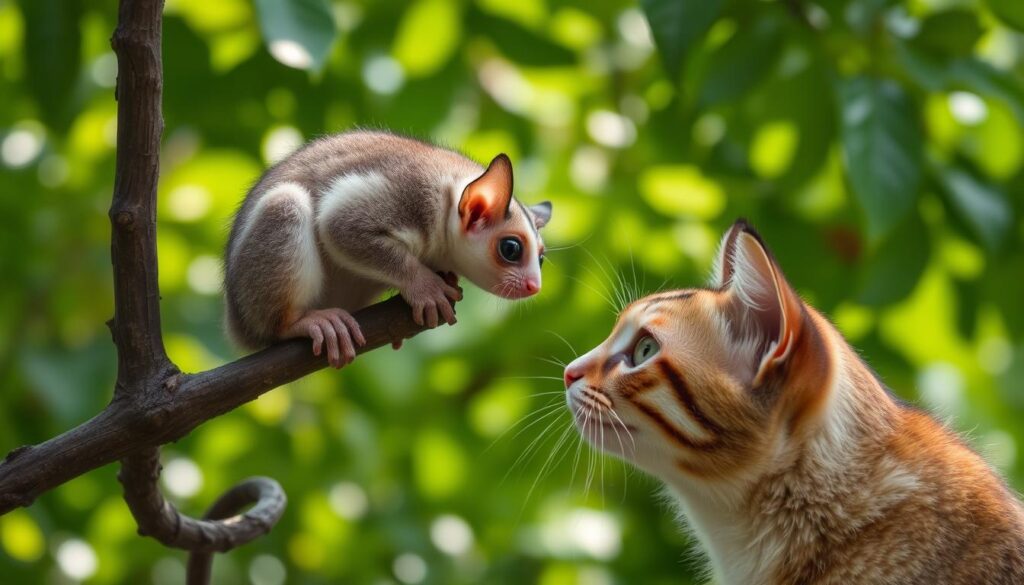
When sugar gliders are near cats, they might show stress signs like vomiting, diarrhea, and feeling weak14. It’s important to spot these signs and act fast to keep your sugar gliders safe. Look out for signs like not wanting to eat, eating too much, sleeping a lot, or running around their cage a lot14.
To reduce stress, it’s key to keep cats away from sugar gliders and their stuff15. Cats might want to chase sugar gliders because of their hunting nature15. Also, cat saliva has harmful bacteria that can hurt sugar gliders15.
Here are some ways to lessen stress for sugar gliders when they’re around cats:
- Keep cats and sugar gliders in different rooms
- Make sure your sugar gliders have a safe place to live
- Don’t let cats meet sugar gliders without watching them closely
By using these tips and knowing the stress signs in sugar gliders around cats, you can make a safe and joyful home for your pets14.
Training Your Cat to Coexist with Sugar Gliders
Training your cat to live with sugar gliders needs patience, consistency, and positive rewards14. Cats can harm sugar gliders because of their natural instincts. So, it’s important to set clear rules and make a safe space for both pets.
Start by slowly introducing your cat and sugar glider to each other. Begin by keeping them in separate rooms. This lets them get used to each other’s smells and sounds. You can also use calming products to help them feel less stressed.
Behavioral Modification Techniques
There are ways to teach your cat to get along with sugar gliders. These include:
- Positive reinforcement training, such as rewarding your cat for calm behavior around the sugar glider
- Desensitization and counterconditioning, which involves gradually exposing your cat to the sugar glider’s presence while associating it with positive experiences
- Environmental changes, such as providing separate areas for your cat and sugar glider to eat, sleep, and play
Every cat is unique, so what works for one might not work for another. Be patient, consistent, and gentle. Always put the safety of both your cat and sugar glider first16.
Establishing Boundaries
Setting clear rules is key when teaching your cat to live with sugar gliders. Make sure they have their own spaces for eating, sleeping, and playing. Always watch them together to stop any fights. With these steps and a gentle approach, you can make a safe and happy home for both pets.
| Tip | Description |
|---|---|
| Provide separate areas | Provide separate areas for your cat and sugar glider to eat, sleep, and play |
| Supervise interactions | Supervise interactions between your cat and sugar glider to prevent aggressive behavior |
| Use positive reinforcement | Use positive reinforcement training to encourage calm behavior around the sugar glider |
Emergency Response: What to Do If Your Cat Attacks Your Sugar Glider
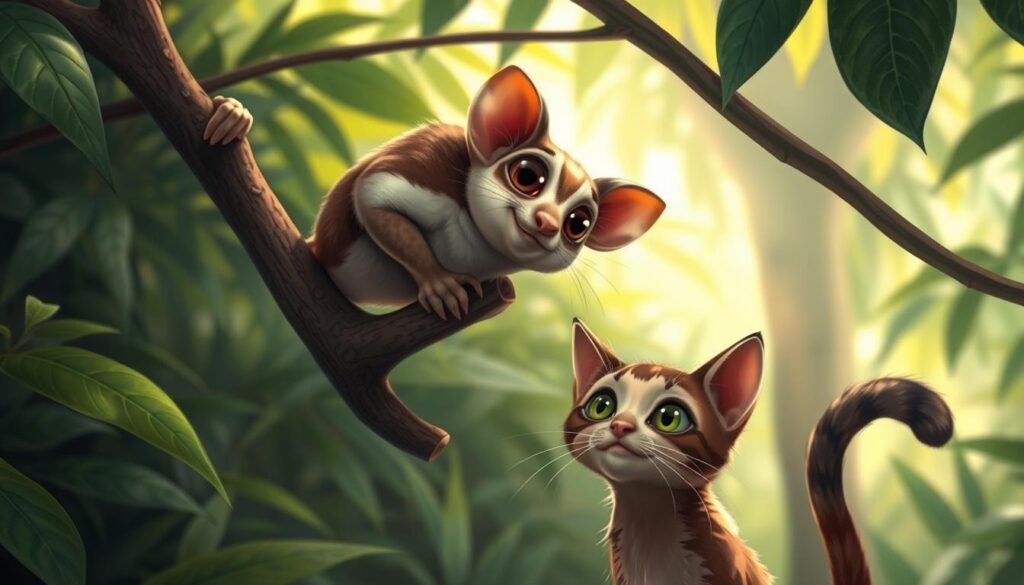
If your cat attacks your sugar glider, having a plan is key17. This plan should cover immediate first aid to keep your sugar glider safe. Experts say sugar gliders and cats can live together, but safety precautions are vital18.
First, separate the cat and sugar glider right away. You can do this by removing the cat or putting the sugar glider in a safe spot17. Then, check the sugar glider for injuries and give it first aid, like cleaning wounds and using antibiotic ointment.
Immediate First Aid Steps
Here are some key first aid steps for a sugar glider attacked by a cat:
- Stop any bleeding by applying gentle pressure to the wound
- Clean the wound with mild soap and water
- Apply antibiotic ointment to prevent infection
- Give the sugar glider a safe and comfy place to recover
Also, keep an eye on the sugar glider’s behavior. Look for signs of stress or illness, like being very tired, not wanting to eat, or having trouble breathing18.
When to Contact a Veterinarian
If the sugar glider’s injuries are bad or it seems sick, call a vet fast17. A vet can give the sugar glider the care it needs and tell you how to help it get better. Sometimes, the sugar glider might need surgery, antibiotics, or other treatments.
Preventive Measures and Daily Management
When caring for sugar gliders, it’s key to prevent accidents and injuries. The third web source says that’s true19. A balanced sugar glider diet is important. It should mainly include protein-rich foods like insects and fruits. Fruits should make up about 25% of their diet19.
Regular grooming is vital to keep sugar gliders healthy. This includes trimming their nails and cleaning their habitat19. It’s also important to understand their emotional needs. Sugar gliders need social interaction and constant companionship for their emotional well-being19. Daily management includes:
- Providing a balanced and nutritious diet
- Ensuring regular grooming and habitat cleaning
- Offering social interaction and companionship
By taking these steps, you can ensure your sugar glider’s health and happiness19.
Alternative Pet Combinations That Work Better
Before bringing new pets into your home, it’s key to check if they get along20. Some pets are better friends than others. If you’re thinking of getting a new pet for your sugar glider, birds or fish might be good choices. They’re not natural hunters.
Looking after sugar gliders means giving them the right food and space. A safe home can be made by picking pets that won’t chase them20. By doing your research, you can make a happy place for all your pets.
Remember, sugar gliders need lots of protein in their food, at least 30%21. Picking pets that need similar food can make your home more balanced. The secret to great pet friends is knowing them well and caring for them deeply.
Conclusion
It’s crucial to keep your sugar gliders safe when you have both exotic pets and domestic cats. Cats are toxic to sugar, which can harm your sugar glider friends22. Knowing what sugar gliders need helps you make a safe space for them.
Keep your pets in separate areas and teach your cat to stay away. Always be ready to help your sugar gliders in an emergency. With care and attention, you can have both cats and sugar gliders as pets safely2223. This guide will help you make a happy home for all your pets.
FAQ
Why are cats toxic to sugar gliders?
What are the natural habitat and behaviors of sugar gliders?
What are the scientific facts behind the toxicity of cats to sugar gliders?
What are the physical dangers of cat attacks on sugar gliders?
How can the bacteria from cat saliva and claws be harmful to sugar gliders?
What are the cage requirements and room setup guidelines for creating a safe environment for sugar gliders?
What are the signs of stress in sugar gliders when they are around cats?
How can you train a cat to coexist with sugar gliders?
What should you do if your cat attacks your sugar glider?
What are the preventive measures and daily management techniques to keep sugar gliders safe?
What are some alternative pet combinations that work better than keeping cats and sugar gliders together?
Source Links
- https://www.petmojo.com/why-are-cats-toxic-to-sugar-gliders-and-small-pets-what-to-know/ – Why Are Cats Toxic to Sugar Gliders and Small Pets? What to Know | PetMojo
- https://www.petmd.com/sugar-glider/exotic/all-about-sugar-gliders – All About Sugar Gliders
- https://www.birdexoticsvet.com/sugar-glider-care-guide – Sugar Glider Care Guide | Long Island Exotic Pet Vet
- https://exoticnutrition.com/blogs/blog/housing-your-sugar-gliders-with-other-pets?srsltid=AfmBOoq4z-y-LMMpa8hzKAfVyBEa3M4KccJoAlxeC7-egEYYITz2oKs8 – Bonding your Sugar Glider with Other Pets
- https://www.thesprucepets.com/sugar-gliders-as-pets-1237334 – Should You Keep a Sugar Glider as a Pet?
- https://vcahospitals.com/know-your-pet/sugar-gliders-feeding – Sugar Gliders – Feeding | VCA Animal Hospitals
- https://sugar-gliders.com/what-not-to-feed-glider-safety/ – What Not to Feed; Glider Safety – Suncoast Sugar Gliders
- https://www.petmd.com/cat/conditions/neurological-disorders-cats – Neurological Disorders in Cats
- https://www.pendervet.com/blog/caring-for-your-pet-sugar-glider – Caring For Your Pet Sugar Glider | Pender Veterinary Centre
- https://catandexoticcare.com/?p=952 – Sugar Gliders – Cat and Exotic Care
- https://canadiansugargliders.com/pages/faq – Sugar Glider FAQ
- http://www.shanti.org/safe_pet_guidelines/ – spg.qxp
- http://www.glidercentral.net/ubbthreads/ubbthreads.php/topics/1389163/re-plastics-and-chemical-toxicities – plastics and chemical toxicities
- https://www.arl-iowa.org/pet-help/resources-for-pet-owners/all-about-pets/sugar-gliders/ – Sugar Gliders | Animal Rescue League of Iowa
- https://exoticnutrition.com/blogs/blog/housing-your-sugar-gliders-with-other-pets?srsltid=AfmBOop9WXgzwVQnkGug9UwKEt_JCu8ebyJrw6sY4_s_2sekVKp8OzUz – Bonding your Sugar Glider with Other Pets
- https://savvypetcare.com/10-things-expect-owning-sugar-gliders/ – 10 Things to Expect When Owning Sugar Gliders – Savvy Pet Care
- https://glidercentral.net/ubbthreads/ubbthreads.php/topics/809328/sugar-gliders-with-birds.html – Sugar Gliders with Birds?
- https://www.environment.nsw.gov.au/-/media/OEH/Corporate-Site/Documents/Animals-and-plants/Native-animals/rescued-possums-gliders-treatment-care-guidelines-210312.pdf – Initial treatment and care guidelines for rescued possums and gliders
- https://aviarynow.com/articles/guide-to-purchasing-sugar-glider/ – A Complete Guide to Buying Your Sugar Glider
- http://www.sugarglider.com/glidergossip/topic.asp?TOPIC_ID=52449 – GliderGossip – Cat and glider
- http://www.glidercentral.net/ubbthreads/ubbthreads.php/topics/21072/Re_Protein_alternatives_Vegeta – Protein alternatives?? (Vegetarian looking)
- https://pangovet.com/pet-health-wellness/sugar-gliders/how-to-take-care-of-a-sugar-glider/ – How to Take Care of a Sugar Glider: Fact Sheet & Advice | PangoVet
- http://eznc.org/CMS/Feeding_Sugar_gliders/show.do?ctx=7795,169951,122043 – EZNC | Feeding Sugar gliders

